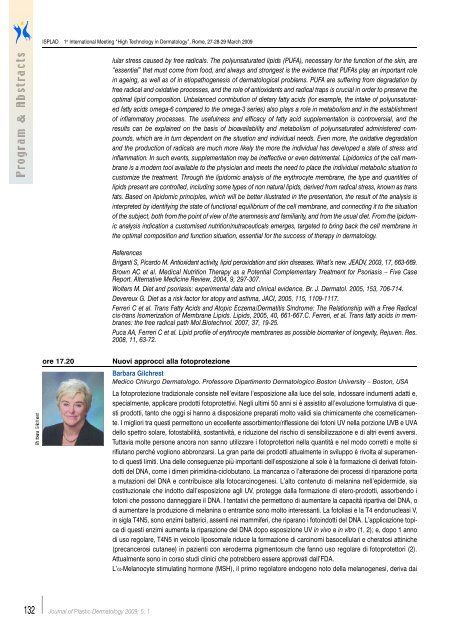Vol. 5, n. 1, January-March 2009 1th International ... - Salute per tutti
Vol. 5, n. 1, January-March 2009 1th International ... - Salute per tutti
Vol. 5, n. 1, January-March 2009 1th International ... - Salute per tutti
You also want an ePaper? Increase the reach of your titles
YUMPU automatically turns print PDFs into web optimized ePapers that Google loves.
132<br />
ISPLAD 1 st <strong>International</strong> Meeting “High Technology in Dermatology”, Rome, 27-28-29 <strong>March</strong> <strong>2009</strong><br />
Journal of Plastic Dermatology <strong>2009</strong>; 5, 1<br />
lular stress caused by free radicals. The polyunsaturated lipids (PUFA), necessary for the function of the skin, are<br />
“essential” that must come from food, and always and strongest is the evidence that PUFAs play an important role<br />
in ageing, as well as of in etiopathogenesis of dermatological problems. PUFA are suffering from degradation by<br />
free radical and oxidative processes, and the role of antioxidants and radical traps is crucial in order to preserve the<br />
optimal lipid composition. Unbalanced contribution of dietary fatty acids (for example, the intake of polyunsaturated<br />
fatty acids omega-6 compared to the omega-3 series) also plays a role in metabolism and in the establishment<br />
of inflammatory processes. The usefulness and efficacy of fatty acid supplementation is controversial, and the<br />
results can be explained on the basis of bioavailability and metabolism of polyunsaturated administered compounds,<br />
which are in turn dependent on the situation and individual needs. Even more, the oxidative degradation<br />
and the production of radicals are much more likely the more the individual has developed a state of stress and<br />
inflammation. In such events, supplementation may be ineffective or even detrimental. Lipidomics of the cell membrane<br />
is a modern tool available to the physician and meets the need to place the individual metabolic situation to<br />
customize the treatment. Through the lipidomic analysis of the erythrocyte membrane, the type and quantities of<br />
lipids present are controlled, including some types of non natural lipids, derived from radical stress, known as trans<br />
fats. Based on lipidomic principles, which will be better illustrated in the presentation, the result of the analysis is<br />
interpreted by identifying the state of functional equilibrium of the cell membrane, and connecting it to the situation<br />
of the subject, both from the point of view of the anamnesis and familiarity, and from the usual diet. From the lpidomic<br />
analysis indication a customised nutrition/nutraceuticals emerges, targeted to bring back the cell membrane in<br />
the optimal composition and function situation, essential for the success of therapy in dermatology.<br />
R e f e r e n c e s<br />
Briganti S, Picardo M. Antioxidant activity, lipid <strong>per</strong>oxidation and skin diseases. What’s new. JEADV, 2003, 17, 663-669.<br />
Brown AC et al. Medical Nutrition Therapy as a Potential Complementary Treatment for Psoriasis – Five Case<br />
Report. Alternative Medicine Review, 2004, 9, 297-307.<br />
Wolters M. Diet and psoriasis: ex<strong>per</strong>imental data and clinical evidence. Br. J. Dermatol. 2005, 153, 706-714.<br />
Devereux G. Diet as a risk factor for atopy and asthma, JACI, 2005, 115, 1109-1117.<br />
Ferreri C et al. Trans Fatty Acids and Atopic Eczema/Dermatitis Sindrome: The Relationship with a Free Radical<br />
cis-trans Isomerization of Membrane Lipids. Lipids, 2005, 40, 661-667.C. Ferreri, et al. Trans fatty acids in membranes:<br />
the free radical path Mol.Biotechnol. 2007, 37, 19-25.<br />
Puca AA, Ferreri C et al. Lipid profile of erythrocyte membranes as possible biomarker of longevity, Rejuven. Res.<br />
2008, 11, 63-72.<br />
ore 17.20 Nuovi approcci alla fotoprotezione<br />
Barbara Gilchrest<br />
Medico Chirurgo Dermatologo. Professore Dipartimento Dermatologico Boston University – Boston, USA<br />
La fotoprotezione tradizionale consiste nell’evitare l’esposizione alla luce del sole, indossare indumenti adatti e,<br />
specialmente, applicare prodotti fotoprotettivi. Negli ultimi 50 anni si è assistito all’evoluzione formulativa di questi<br />
prodotti, tanto che oggi si hanno a disposizione preparati molto validi sia chimicamente che cosmeticamente.<br />
I migliori tra questi <strong>per</strong>mettono un eccellente assorbimento/riflessione dei fotoni UV nella porzione UVB e UVA<br />
dello spettro solare, fotostabilità, sostantività, e riduzione del rischio di sensibilizzazione e di altri eventi avversi.<br />
Tuttavia molte <strong>per</strong>sone ancora non sanno utilizzare i fotoprotettori nella quantità e nel modo corretti e molte si<br />
rifiutano <strong>per</strong>ché vogliono abbronzarsi. La gran parte dei prodotti attualmente in sviluppo è rivolta al su<strong>per</strong>amento<br />
di questi limiti. Una delle conseguenze più importanti dell’esposizione al sole è la formazione di derivati fotoindotti<br />
del DNA, come i dimeri pirimidina-ciclobutano. La mancanza o l’alterazione dei processi di riparazione porta<br />
a mutazioni del DNA e contribuisce alla fotocarcinogenesi. L’alto contenuto di melanina nell’epidermide, sia<br />
costituzionale che indotto dall’esposizione agli UV, protegge dalla formazione di etero-prodotti, assorbendo i<br />
fotoni che possono danneggiare il DNA. I tentativi che <strong>per</strong>mettono di aumentare la capacità ripartiva del DNA, o<br />
di aumentare la produzione di melanina o entrambe sono molto interessanti. La fotoliasi e la T4 endonucleasi V,<br />
in sigla T4N5, sono enzimi batterici, assenti nei mammiferi, che riparano i fotoindotti del DNA. L’applicazione topica<br />
di questi enzimi aumenta la riparazione del DNA dopo esposizione UV in vivo e in vitro (1, 2); e, dopo 1 anno<br />
di uso regolare, T4N5 in veicolo liposomale riduce la formazione di carcinomi basocellulari e cheratosi attiniche<br />
(precancerosi cutanee) in pazienti con xeroderma pigmentosum che fanno uso regolare di fotoprotettori (2).<br />
Attualmente sono in corso studi clinici che potrebbero essere approvati dall’FDA.<br />
L’"-Melanocyte stimulating hormone (MSH), il primo regolatore endogeno noto della melanogenesi, deriva dai

















